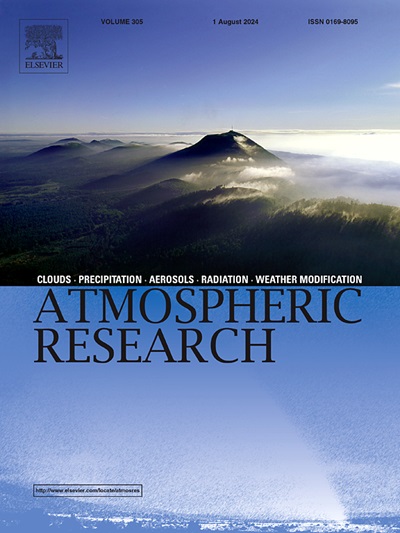北美西部夏季长寿命热浪的特征和机制:来自Rossby波列的视角
IF 4.5
2区 地球科学
Q1 METEOROLOGY & ATMOSPHERIC SCIENCES
引用次数: 0
摘要
大气热浪事件具有重要的社会经济影响,在全球气候变化背景下已被广泛研究。本研究探讨了长周期和短周期热浪事件(LHWs和SHWs)的特征和差异。首先,我们确定了1981-2022年北美西部(WNA)的热浪事件,并根据其持续时间参数的第90百分位对其进行了分类。结果表明,强震地表增温更强,暖层更厚、更强。环流异常表现为西高压区上方有一个异常脊,该异常脊持续时间较长,低压高压高度正异常中心值较大。此外,我们还揭示了中高纬度遥相关在维持强子波中的重要作用。研究发现,日本附近降水增加所释放的非绝热加热可以激发罗斯比波列穿越太平洋到达北美,这有助于维持强震异常脊。此外,西伯利亚中部与陆-气相互作用有关的正绝热加热异常也有利于异常脊的产生或持续,从而有利于强震。最后,利用线性斜压模型和5.0社区大气模型验证了上述遥相关机制。相比之下,在强震高峰之前,罗斯比波能量的跨太平洋传播可以忽略不计。本研究提供了东亚和中西伯利亚与WNA气候联系的证据,这可能为WNA上的LHWs提供潜在的可预测性。本文章由计算机程序翻译,如有差异,请以英文原文为准。
Characteristics and mechanisms of summer long-lived heatwaves in Western North America: Perspective from Rossby wave train
Atmospheric heatwave events have substantial socioeconomic impacts, which have been widely studied under global climate change. This study investigates the characteristics and differences between long-lived and short-lived heatwave events (LHWs and SHWs). First, we identify heatwave events over the Western North America (WNA) over 1981–2022 and categorize them based on the 90th percentile of their duration parameter. Then, we reveal that the LHWs exhibit stronger surface warming with a stronger and thicker warm layer. Circulation anomalies show an anomalous ridge above the WNA, which is more persistent with a greater central value of positive geopotential height anomalies for LHWs. Furthermore, we reveal the important role of mid-to-high-latitude teleconnection in maintaining the LHWs. We find that the diabatic heating released by increased precipitation near Japan can excite Rossby wave trains crossing the Pacific Ocean, and then reach North America, which contributes to maintaining the anomalous ridge of LHWs. Moreover, positive diabatic heating anomalies, related to land-atmosphere interaction, in Central Siberia are also favorable for the generation or persistence of the anomalous ridge and thus the LHWs. Finally, we validate the above teleconnection mechanisms by using the linear baroclinic model and Community Atmosphere Model 5.0 model. By comparison, there is negligible cross-Pacific propagation of Rossby wave energy before the peak of SHWs. This study presents evidence of climate linkages of East Asia and Central Siberia with WNA, which may provide potential predictability for LHWs over the WNA.
求助全文
通过发布文献求助,成功后即可免费获取论文全文。
去求助
来源期刊

Atmospheric Research
地学-气象与大气科学
CiteScore
9.40
自引率
10.90%
发文量
460
审稿时长
47 days
期刊介绍:
The journal publishes scientific papers (research papers, review articles, letters and notes) dealing with the part of the atmosphere where meteorological events occur. Attention is given to all processes extending from the earth surface to the tropopause, but special emphasis continues to be devoted to the physics of clouds, mesoscale meteorology and air pollution, i.e. atmospheric aerosols; microphysical processes; cloud dynamics and thermodynamics; numerical simulation, climatology, climate change and weather modification.
 求助内容:
求助内容: 应助结果提醒方式:
应助结果提醒方式:


